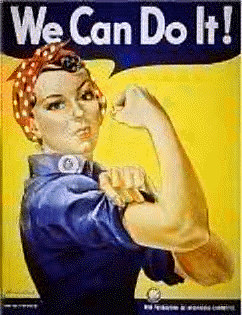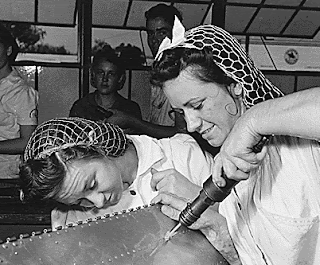Women were acting within biblical boundaries. They were not in positions of authority over men. They worked hard to support their households; a virtue highly respected in the Bible (Proverbs 31). Their roles changed in the world as the war progressed and they were forever changed. They gained value and respect in the workforce that was reversed after the war, but not totally. It is not against the Bible for women to work jobs that men might otherwise have; think of Lydia
Tuesday, 29 March 2011
Conclusion
Women played an extremely important role in the war by being a support to soldiers, families, and all of Canada
Inequalities
Despite the fact that women were doing the same work the men did, they were paid much less than men. Daycare and tax breaks were provided for women during the war, but were pulled out afterward, making it very hard for widows to provide for their families after the war. In addition, women's position in society felt a decrease after the war as men returned from the war; as the men returned, they needed work, and the women were expected to vacate their jobs to make room for the men.
Propoganda
Women were a much needed resource. In response to the great need governements came out with a series of propoganda messages:
This is Rosie: a mascot for all the women workers
This poster was meant to encourage the women working on the homefront
This is a governmnet-issued recruiting request poster urging women to join
please follow the link to veiw a message meant to motivate women to work. It also shows example shots of women working in the factories and tells you why they needed the women workers.
Tuesday, 22 March 2011
On the Homefront
Women's roles were not always as dramatic as oversea service, most women that served, served on the homefront. Many felt they were needed at home, which was true.
Men had vacated a lot of jobs as they left for battle, leaving empty gaps in the workforce. On top of raising families, women were called upon to work in machine and welding shops and manufacturing plants to provide equipment like weapons, vehicles, uniforms, ammunition, and other necessities. Crops still needed planting, plowing, and harvesting lest the food shortage grow; so those jobs were filled too.
Young, single women found working easier, but mothers made things work with great determination. They kept jobs and a neat household while raising children all at once.
Since the Canadian workforce felt a dramatic increase in the number of women, factories began to operate twelve hours a day, seven days a week. Over 1 million women were working by 1944.
Men had vacated a lot of jobs as they left for battle, leaving empty gaps in the workforce. On top of raising families, women were called upon to work in machine and welding shops and manufacturing plants to provide equipment like weapons, vehicles, uniforms, ammunition, and other necessities. Crops still needed planting, plowing, and harvesting lest the food shortage grow; so those jobs were filled too.
Young, single women found working easier, but mothers made things work with great determination. They kept jobs and a neat household while raising children all at once.
Since the Canadian workforce felt a dramatic increase in the number of women, factories began to operate twelve hours a day, seven days a week. Over 1 million women were working by 1944.
Women worked in factories making many different types of war supplies;
this picture most likely shows a uniform factory
this picture most likely shows a uniform factory
Women welding in a factory manufacturing weapons, vehicles, and other war supplies
Spies
Women in the Forces usually stayed behind front lines, but women working for the Special Operations Executive (SOE) worked behind enemy lines. They were parachuted into occupied France as spies. As saboteurs couriers, and radio operators, they provided vital information and advantages for the Allies.
SOE Agent, Vera Atkins (Romanian)
The Women's Divisions
There were several women's divisions opened during the course of the war. The first opened to them was the Auxilary Corps. Women worked as clerks, vehicle drivers, messengers, and canteen workers. Despite the fact that they were replacing men on the job, they were only paid two thirds the amount than men.
In July, 1942, the Royal Canadian Air Force was opened to women in a division called the Candian Women's Auxilary Air Force (CWAAF). Women didn't fly in combat, but they were desperately needed as ground crews, which they willingly were. The Navy was also opened that month.
Women in the Auxilary Corps.
In July, 1942, the Royal Canadian Air Force was opened to women in a division called the Candian Women's Auxilary Air Force (CWAAF). Women didn't fly in combat, but they were desperately needed as ground crews, which they willingly were. The Navy was also opened that month.
A few women who served in the Air Force
Finally, August 1945, the Army Corps. was opened. 21,000 women served in what they saw as the "real war". They were called WAACs (Women's Army Auxilary Corps.) Positions like cooks, nurses, non-combative pilots, mechanics, welders, and radar operators were all filled by women. Coastal defence and pilots for the Atlantic Ferry Command were important, they protected ships during the perilous Atlantic journey. It was a dangerous job; over 500 pilots died while on Ferry flight.
Women Mechanics
A Woman Nurse Near the Battlefront
Wednesday, 2 March 2011
Introduction
Over the course of WWII, the role of women in the world changed. The war could not have been fought and won as quickly as it was without women. Women served both in the home country and overseas, and were valuable assets in both settings.
Subscribe to:
Posts (Atom)










